With an abundance of fish species in the world, it is easy to forget about all of the ones in the water. One type that seems to come out of fiction is the electric fish. There are around 350 types of electric fish in the world. A fish that is able to generate electricity is called electrogenic, but some can also detect electric fields, which are electropositive. Sharks, catfish, and stingrays are some common species that can detect electricity, but it is much rarer for a species to be able to produce electricity.

The types of electric fish that are able to produce a charge, are able to because of their electric organ. This organ is made from modified organs and nerve cells that evolved able to produce a larger charger. Communication and defense are the primary uses of this electric organ. Waters in Africa, India, South America, and the ocean are where most species of electric fish live. As we go down this list you will find 10 types of electrical fish and interesting things to know about each one.
10. Glass Knifefish
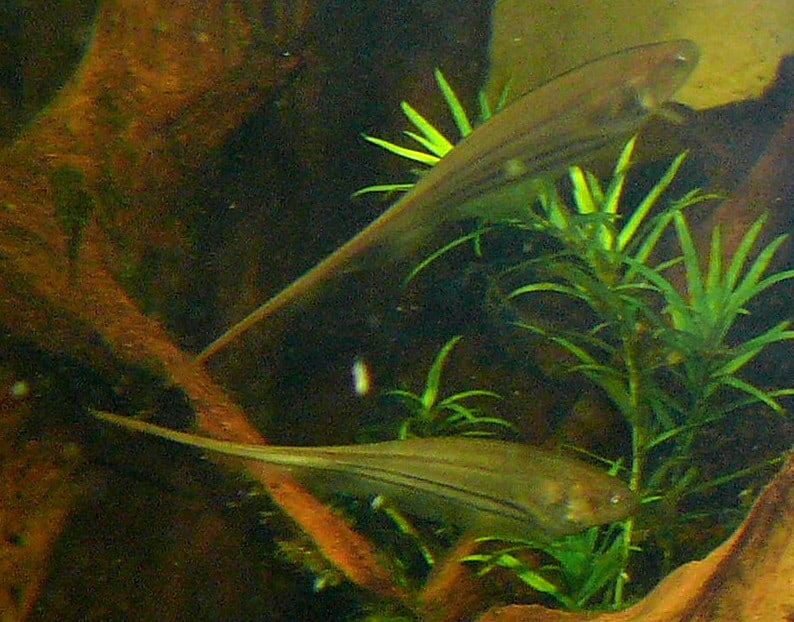
The glass knifefish is also known as the rat tail knife fish.
©User:Haplochromis, CC BY-SA 3.0 – License
Originating from South America, Africa, and Asia the glass knife fish has become a popular species to keep in an aquarium. Belonging to the Sternopygidae family, they are also known as the rat tail knife fish. Large freshwater rivers like the Amazon with deep fast-moving water are where they are most commonly found.
Reaching up to 17 inches in size, they have a lifespan of around 3 to 6 years. Their bodies are transparent with no dorsal fin. The electric organ in their body only produces a weak current and is mostly used for communication. As a hardy species, they can be kept as a pet in aquariums but not with small fish since they are predators in the wild. Because they are a species with no scales, they are more susceptible to disease.
9. Pacific Electric Ray
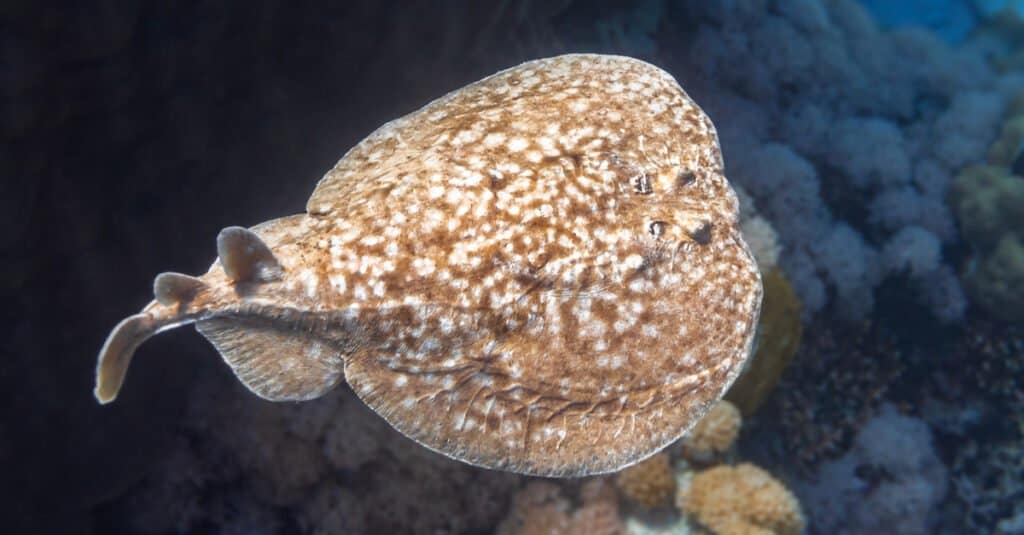
The Pacific electric ray can produce around 45 volts
©maya_parf/Shutterstock.com
It is common for some stingrays to be able to produce an electric charge, and the Pacific electric ray, (Tetronarce californica) is one of those species. Living in the Pacific Ocean on the Western coast of North America, they will inhabit sandy flats, rocky reefs, and kelp forests at depths of around 200 meters (660 ft). They are thick and flabby with an oval-like body. Dark grey to blue is their coloring. Averaging 55 inches in length they can weigh up to 90 pounds.
Shocks of these fish are produced on the side of their body where their electric organ is located. Able to produce around 45 volts, they hover around prey and shock them when hunting. The night is when they hunt preying on small bony fish. Fishermen casting off piers occasionally come across this species and must grab them by the tail to avoid being shocked.
8. Black Ghost Knifefish
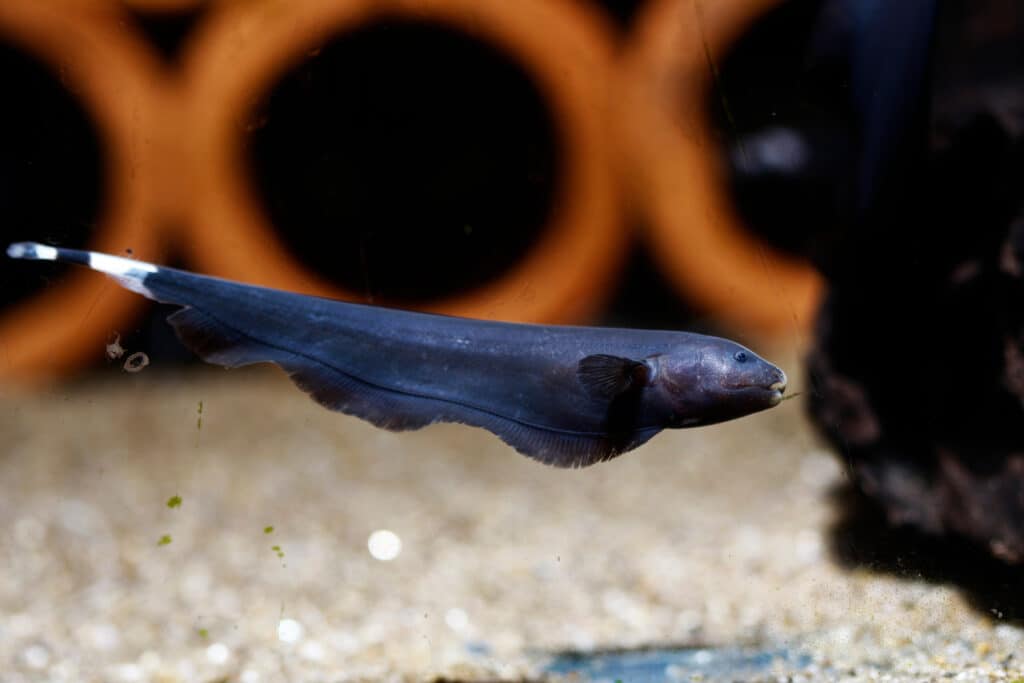
Knifefish swim by rippling their anal fins while keeping their bodies rigid.
©Pavaphon Supanantananont/Shutterstock.com
The black ghost knife fish is a freshwater species that uses electricity to navigate. While the electricity produced is not enough to shock, they are blind and emit electricity to navigate. They are bottom feeders found in tropical waters in Southern America.
Entirely black, they have two white rings on their tail and a white stripe on their nose. They get their name from their shape, which looks like a knife. This species is a popular pet to keep and can live well with other large species. Feeding on insects, larvae, and other large fish, they are mostly nocturnal. Hunting is also done by use of their electric field, as their eyesight is not developed since they are mostly active at night. Sometimes they are aggressive and have a beak that can cause little harm to humans.
7. Common Torpedo
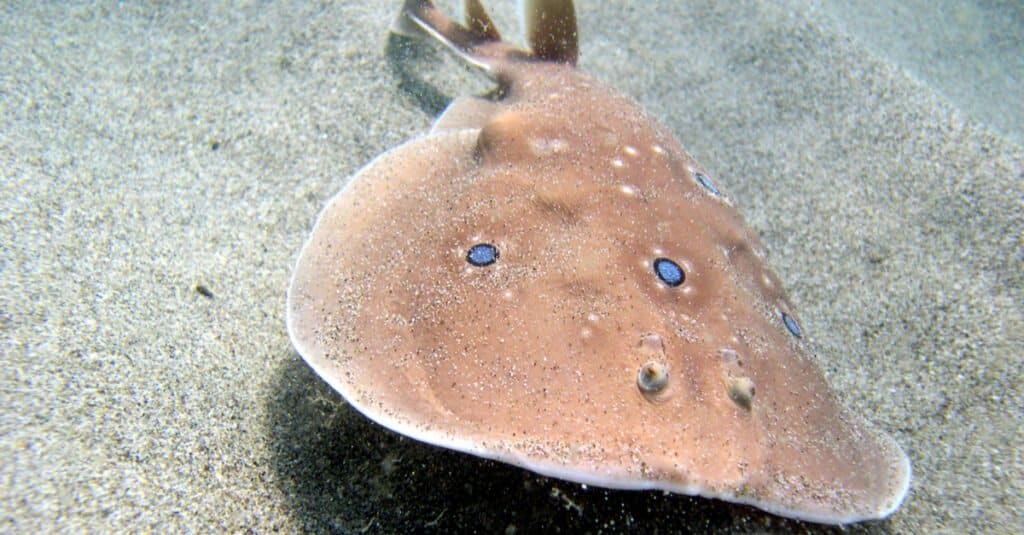
The common torpedo inhabit the Mediterranean Sea and parts of the Eastern Atlantic Ocean.
©Gennaro DiBs/Shutterstock.com
Common Torpedos also called the torpedo fish (torpedo torpedo) is a species of electric ray in the Torpedinidae family. They inhabit the Mediterranean Sea and parts of the Eastern Atlantic Ocean. Torpedoes emit an electric shock of around 200 volts, used to shock predators or fish it is hunting. They have been found in as deep waters as 400 m (1,300 ft).
Soft-bottom habitats are where they will generally live, occasionally burrowing themselves in the ground. In the night they hunt and are considered an ambush predator. Bony fish like mackerel and herring are stunned with electricity and then eaten. If a human is shocked it can cause nerve damage but is usually not life-threatening.
6. Cornish Jack

Cornish jacks are a demersal species living in tropical freshwater habitats.
©George Albert Boulenger, Public domain – License
Cornish jacks are able to produce weak pulses of electricity from their electric organ. Finding food and communication is what they use their electrical pulse for, as their charge is too weak to harm. Cornish jacks are a demersal species living in tropical freshwater habitats. They can be found in the White Nile, Lake Albert drainage basin, and inland waters in Africa. With an elongated head and body, they have a gray coloration with a light bronze belly. Fish, crustaceans, and insect larvae are what they feed on.
5. Electric Catfish (Malapterurus electricus)

Electric catfish close-up. The catfish can discharge a shock of up to 450 volts to defend itself and capture prey.
©Pavaphon Supanantananont/Shutterstock.com
One of the more unique species of catfish is the electric catfish (Malapterurus electricus), native to the rivers in Central and West Africa. In the family of Malapterurs, there are only two species, The electric catfish and smallmouth electric catfish. The largest of this species will grow to around 3 feet, and they keep the look of your average catfish.
Similar to whickers and body the shape of other catfish, they are able to produce a medium voltage, around 300 to 400 volts. This is used to stun prey and defend themselves from predators. Electric catfish are sometimes kept as pets, but can not be housed with other fish that aren’t the same species. They will stun and kill other fishes but are immune to their own shock. Areas within the U.S like rivers and lakes similar to their endemic habitat have some populations of this species due to its invasive and dominant nature.
4. Electric Eel (Electrophorus electricus)

Three Electric
Eels
©tristan tan/Shutterstock.com
Electrophorus electricus is more widely known as the Electric eel, inhabiting rivers in parts of South America like the Guyanas, Orinoco, and parts of the Amazon rivers. They inhabit muddy bottoms with dense vegetation and shading. Unlike other fish, the electric eel gains most of its oxygen from going to the surface and breathing in air. Electric eels closely resemble other eels but are actually ostariophysan. They have long snake-like bodies and apowerful electric organ that develops as they age. When fully grown they are enabled to produce around 600 volts, used to stun prey and ward off predators. This was originally thought to be the only electric eel species, but with more research in the Amazon, scientists were able to find two more species of the electric eel.
3. Voltas Electric Eel (Electrophorus voltai)

This eel is named in honor of the physicist Alessandro Volta, who is widely credited as the creator of the electric battery.
©C. David de Santana, William G. R. Crampton, Casey B. Dillman, Renata G. Frederico, Mark H. Sabaj, Raphaël Covain, Jonathan Ready, Jansen Zuanon, Renildo R. de Oliveira, Raimundo N. Mendes-Júnior, Douglas A. Bastos, Tulio F. Teixeira, Jan Mol, Willian Ohara, Natália Castro e Castro, Luiz A. Peixoto, Cleusa Nagamachi, Leandro Sousa, Luciano F. A. Montag, Frank Ribeiro, Joseph C. Waddell, Nivaldo M. Piorsky, Richard P. Vari & Wolmar B. Wosiacki, CC BY 4.0 – License
Having the crown of the most powerful electrical animal on the planet, the voltas electric eel (Electrophorus voltai) is a newly discovered species able to produce around 850 volts with its charge. This voltage is the strongest of any animal and beats second place by 250 volts. Found in freshwater rivers in South America they will reach up to 8 feet in length. Usually active at night, they will hunt in packs preying on fish resting in shallow waters. Able to incapacitate a human with this charge, the voltas electric eel shows us the variety of life found in the Amazon. Their charge is mostly used for hunting, and they have been seen in groups as large as 30.
2. Coffin Ray (Hypnos monopterygius)
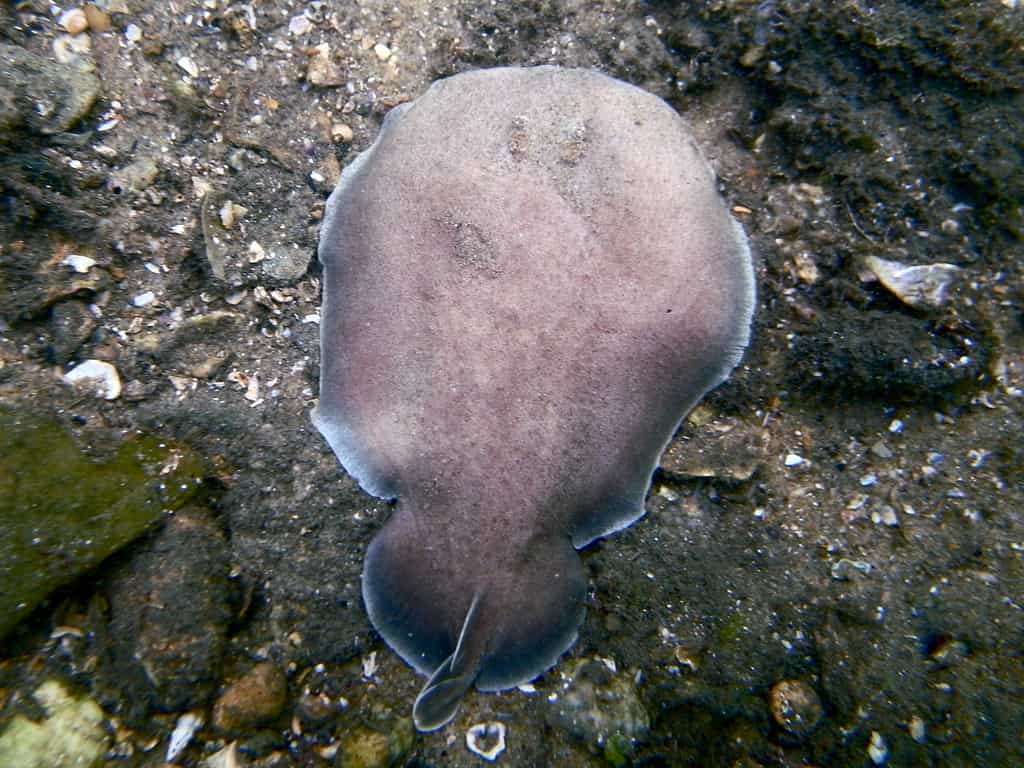
Coffin rays are able to procure a powerful voltage of around 250 watts.
©Sylke Rohrlach, CC BY-SA 3.0 – License
Coffin Rays (Hypnos monopterygius) are an electric ray species found on the coasts of Australia. They live at depths of around 80m (260 ft). Divers and swimmers can find this species burrowed in the sand during the day. They are nocturnal and spend their time on the seafloor. Coffin rays are able to procure a powerful voltage of around 250 watts, capable of shocking multiple times. Their name is fitting as they are able to knock humans off their feet and numb their limbs with their shock.
Coffin rays have a pearl-like flabby body. Their electric organ is visible on both sides of their body. They have an enlarged pectoral fin disk and a tiny tail. Growing to around 16 inches they are usually grey or black in color. Their shock and camouflage are their main defenses against predators. As slow and weak swimmers, they will remain still to try and hide from predators.
1. Northern Stargazer
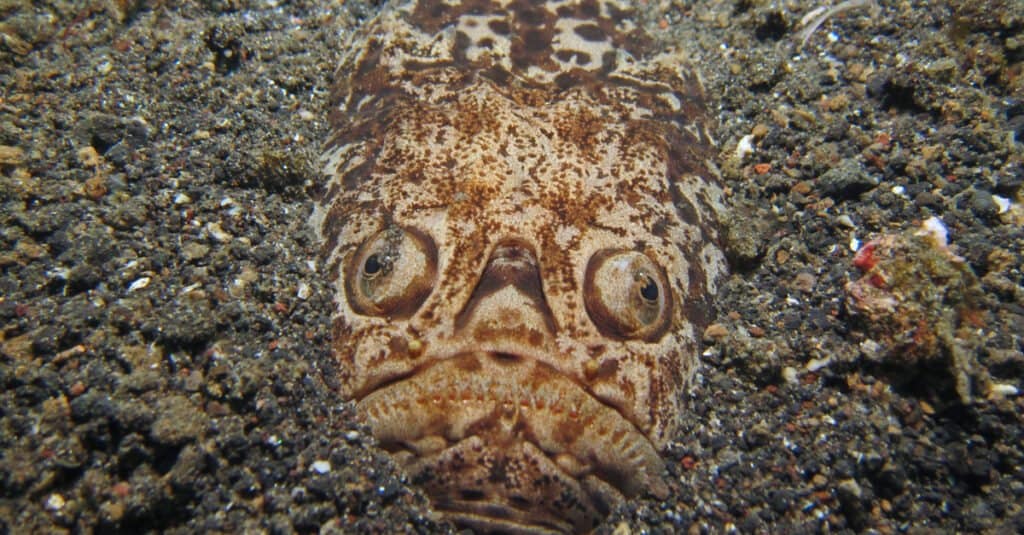
A stargazer preparing to ambush prey at the bottom of the ocean
©Luke Suen/Shutterstock.com
Northern Stargazers are one of the scariest-looking species of electric fish. Large round bodies, big mouths shaped in a frown with sharp teeth, and tiny eyes are some of their characteristics. Reaching up to 22 inches in size their skin is dark tan. Living at the bottom of deep oceans in open waters, they are most commonly found along the Atlantic Coast in Eastern North America.
Northern Stargazers hide and bury themselves in the sand, coming out to consume passing by prey. Their shock is small, around 50 volts, and used mostly for warding off predators. When handled by humans, shock is harmless, but they are also a venomous species. Large spines on their pectoral fin are where the venom lies and can be extremely painful to humans.
Summary of 10 Types of Electric Fish
| Number | Electric Fish |
|---|---|
| 1 | Northern Stargazer |
| 2 | Coffin Ray |
| 3 | Voltas Electric Eel |
| 4 | Electric Eel |
| 5 | Electric Catfish |
| 6 | Cornish Jack |
| 7 | Common Torpedo |
| 8 | Black Ghost Knifefish |
| 9 | Pacific Electric Ray |
| 10 | Glass Knifefish |
The photo featured at the top of this post is © Luke Suen/Shutterstock.com
Thank you for reading! Have some feedback for us? Contact the AZ Animals editorial team.






